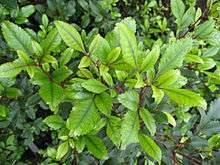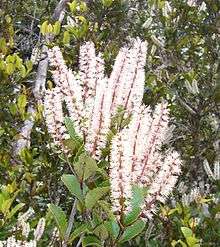Weinmannia racemosa
| Kāmahi | |
|---|---|
 | |
| Scientific classification | |
| Kingdom: | Plantae |
| (unranked): | Angiosperms |
| (unranked): | Eudicots |
| (unranked): | Rosids |
| Order: | Oxalidales |
| Family: | Cunoniaceae |
| Genus: | Weinmannia |
| Species: | W. racemosa |
| Binomial name | |
| Weinmannia racemosa | |

Weinmannia racemosa, commonly called kāmahi, is an evergreen small shrub to medium-sized tree of the family Cunoniaceae.[1] It is the most abundant forest tree in New Zealand,[2] occurring in lowland, montane, and subalpine forests and shrubland from the central North Island south to Stewart Island.
Description
Kāmahi bears racemes of small, pink or white flowers from July to January. Fruits are small capsules, 4–6 mm (0.16–0.24 in) long, ripening from October to May.[1] Kāmahi generally occurs with other broadleaf trees, at times acting as a pioneer species which is eventually succeeded by the southern beeches (Nothofagus spp.) or podocarps. It reaches 25 m (82 ft) or more in the Catlins of the south-eastern South Island. In forests to the west of the Southern Alps it codominates with southern rātā (Metrosideros umbellata) and black beech (N. solandri).[3] A closely related tree, tōwai or tawhero (W. silvicola), replaces kāmahi in the North Island north of latitude 38°S.[4]
Uses
The bark is very high in tannin, about 13%,[5] and was once exported for tanning. The inner bark was used as a laxative by Māori.[6] The wood has a tendency to warp or crack, so it is little used despite the tree's abundance.[2]
References
- 1 2 de Lange, P. J. "New Zealand Plant Conservation Network". Retrieved 2013-11-22.
- 1 2 Poole, A. L. "Kamahi - 1966 Encyclopedia of New Zealand". Retrieved 2007-06-19.
- ↑ "Land Care Research: Kāmahi-southern rata forest". Retrieved 2013-11-24.
- ↑ "Flora of New Zealand". Retrieved 2013-11-24.
- ↑ L.f. "Plants for a Future". Retrieved 2013-11-22.
- ↑ "Māori Plant Use". Retrieved 2013-11-22.
Further reading
- Metcalf, Laurie, 2002. A Photographic Guide to Trees of New Zealand. Tāmaki-makau-rau: New Holland.
- Salmon, J.T., 1986. The Native Trees of New Zealand. Te Whanga-nui-a-Tara: Heinneman Reed.
| Wikimedia Commons has media related to Weinmannia racemosa. |